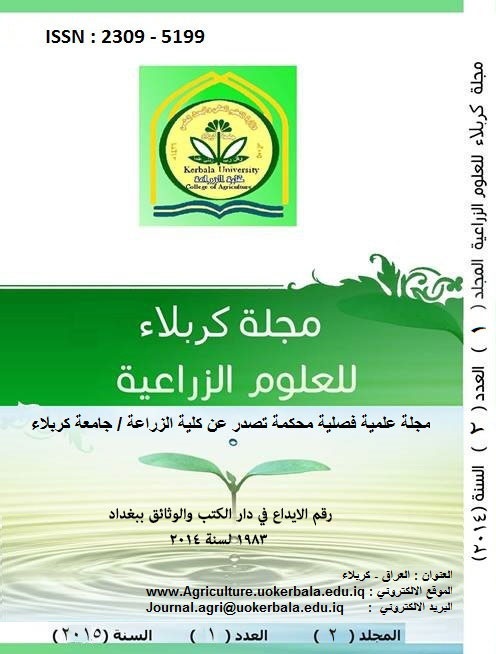Biological control of root rot disease eggplant caused by fungus Fusarium solani
DOI:
https://doi.org/10.59658/jkas.v3i1.530Keywords:
الك Fusarium solani , Pseudomonas fluorescens , subtilis Bacillus , B.cereus×Abstract
The results of the isolates from the roots of, eggplant , diagnosis the presence of fungus F. solani that causes root rot of eggplant in six locations in the province of Babylon , Showed the results of an experiment pots under the conditions of the lathhous all treatments led to significant reduction in the severity of the injury for the isolated fungus (Fs6) F.solani All treatments Bacillus subtilis + Peudomonas fluorescens , and bacteria B.cereus + P.fluorescens and bacteria B.subtilis + B.cereus in the presence of pathogenic fungus that were used by 15 ml / potted a significant reduction in the percentage of the severity of the injury to the egg plants which was 6.25% , 6.25% and 12.5% , respectively, compared to the control treatment (pathogenic fungus alone ), which was 81.25%. As for the results of the experiment under the plastic house conditions all treatments results a significant reduction in the percentage of the severity of the injury for fungus (Fs6) F.solani between the made bacteria B.subtilis + P.fluorescens , and bacteria B.cereus + P.fluorescens and bacteria B.subtilis + B.cereus the presence of pathogenic fungus significantly results in the percentage of the severity of injury to the egg plants which was 11.75 13.00 and 14.25 %, respectively, compared to the control treatment of pathogenic fungus alone and that the severity of the injury was 85.00% Bio-fertilization with bacteria B.subtilis +P. fluorescens and bacteria B.cereus + P. fluorescens and bacteria B.subtilis + B.cereus results, in the increase in the productivity of eggplant with and without the presence of pathogenic fungus (Fs6) F.solani, reaches to 16.32, 14.69 and 13.31 kg / plant and 19.31, 18.34 and 17.93 kg / plant, respectively compared to the control treatment with and without the existence of pathogenic fungus, which has 2.04 and 15.07 kg /plant, respectively .
Downloads
Published
How to Cite
Issue
Section
License
Copyright (c) 2016 Copyright (c) 2024 is the Author's article. Published by the Journal of Kerbala for Agricultural Sciences under a CC BY 4.0 license

This work is licensed under a Creative Commons Attribution 4.0 International License.
Licensing Terms
All articles are published under a Creative Commons License and will be directed to the Creative Commons Attribution 4.0 International License (CC BY 4.0) That permits use, distribution, and reproduction in any medium, provided the original work is properly cited. This license also allows the work to be used for commercial purposes.
Use by both non-commercial and commercial users
This content is licensed under a Creative Commons Attribution 4.0 International (CC BY 4.0) license, permitting use by both non-commercial and commercial users. Individual users may access, download, copy, display, and redistribute the articles to colleagues, as well as adapt, translate, and text- and data-mine the content, subject to the following conditions:
- The author's moral rights, including the right of attribution and the right to protect their work from derogatory treatment, are respected.
- Where content in the article is identified as belonging to a third party, users must ensure that any reuse complies with the copyright policies of the owner of that content.
- If the article content is reused for research or educational purposes, users should maintain a link to the appropriate bibliographic citation, including the DOI and a link to the published version on the journal's website.

